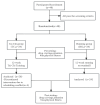Effect of Tai Chi Compared to Running on Drug Cravings, Attention Bias, and Physical Fitness in Men with Methamphetamine Use Disorder
- PMID: 39201211
- PMCID: PMC11353623
- DOI: 10.3390/healthcare12161653
Effect of Tai Chi Compared to Running on Drug Cravings, Attention Bias, and Physical Fitness in Men with Methamphetamine Use Disorder
Abstract
Background: Methamphetamine use disorder (MUD) is a global health problem. Studies have shown Tai Chi is a potential treatment for MUD. We aimed to explore the effectiveness of Tai Chi in improving drug cravings, attention bias, and physical fitness in men with MUD compared with aerobic exercise.
Methods: A total of forty-eight participants (mean age 39.1 ± 8.7 years) were randomly assigned to either the Tai Chi group (TC) or the running group (RG). The TC performed 60 min of moderate-intensity (65-75% HRmax) Tai Chi exercise three times a week. The RG performed 60 min of moderate-intensity (65-75% HRmax) running on a treadmill three times a week. Before and after the intervention, drug cravings, attention bias, and physical fitness were evaluated.
Results: After 12 weeks, we found the TC significantly improved in attention bias (F (1, 43) = 6.023, p = 0.019, d = -0.42) and reaction time (F (1, 43) = 6.181, p = 0.017, d = -0.72). No significant improvement was found in other variables in the TC, compared to the RG (p > 0.05).
Conclusions: The 12-week Tai Chi intervention improved attention bias and reaction time, compared to RG. Tai Chi exercise might be a potential auxiliary method for the rehabilitation for men with MUD.
Keywords: Tai Chi; attention bias; methamphetamine use disorder; physical fitness.
Conflict of interest statement
The authors declare no conflict of interest.
Figures
References
-
- World Drug Report 2022. [(accessed on 3 July 2024)]. Available online: www.unodc.org/unodc/en/data-and-analysis/world-drug-report-2022.html.
Grants and funding
LinkOut - more resources
Full Text Sources





